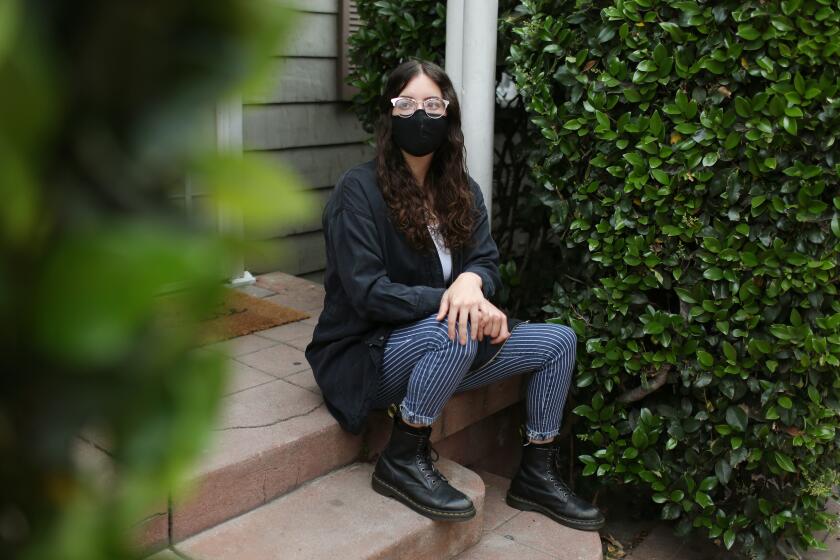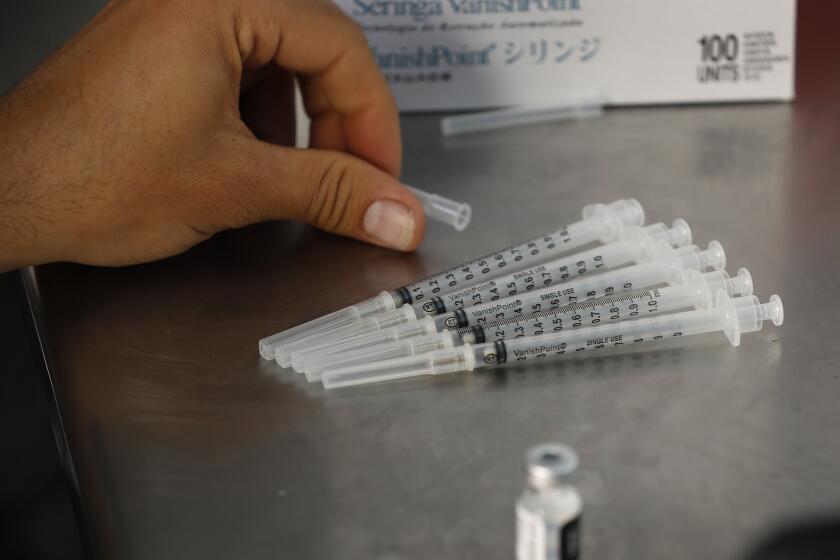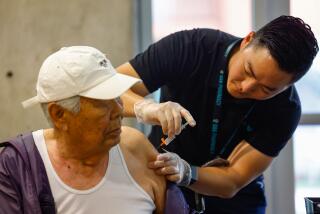COVID-19 hospitalizations tumble among U.S. senior citizens

- Share via
WASHINGTON — COVID-19 hospitalizations among older Americans have plunged more than 70% since the start of the year, and deaths among them appear to have tumbled as well — dramatic evidence the vaccination campaign is working.
Now the trick is to get more of the nation’s younger people to roll up their sleeves.
The drop-off in severe cases among Americans 65 and older is especially encouraging because senior citizens have accounted for about 8 out of 10 deaths from the virus since it hit the U.S., where the toll stands at about 570,000.
COVID-19 deaths among people of all ages in the U.S. have plummeted to about 700 per day on average, compared with a peak of over 3,400 in mid-January.
“What you’re seeing there is exactly what we hoped and wanted to see: As really high rates of vaccinations happen, hospitalizations and death rates come down,” said Jodie Guest, a public health researcher at Emory University in Atlanta.
The best available data suggest COVID-19 deaths among Americans 65 and older have declined more than 50% since their peak in January. The picture is not entirely clear because the most recent data on deaths by age from the Centers for Disease Control and Prevention is incomplete and subject to revision.
Still, the figures suggest that the fall in deaths among senior citizens is driving the overall decline in lives lost to COVID-19, vindicating the U.S. strategy of putting elderly people at or near the front of the line for shots when the vaccine became available over the winter.
With so many Americans becoming immunized, it’s natural to look ahead and wonder how long this protection will last. The answer: No one knows.
The U.S. trends mirror what is happening in other countries with high vaccination rates, such as Israel and Britain, and stand in stark contrast with the worsening disaster in places like India and Brazil, which lag far behind in dispensing shots.
According to U.S. government statistics, hospitalizations are down more than 50%, but most dramatically among senior citizens, who have been eligible for shots the longest and have enthusiastically received them.
Two-thirds of American senior citizens are fully vaccinated, versus just one-third of all U.S. adults. Over 80% of senior citizens have gotten at least one shot, compared with just over 50% of all adults.
We seem to be on the cusp of returning to normal life, but for many people, transitioning back to Before Times is proving to be a lot more fraught than we expected.
At the same time, however, overall demand for vaccinations in the U.S. seems to be slipping, even as shots have been thrown open to all adults across the country. The average number of doses administered per day appeared to fall in mid-April from 3.2 million to 2.9 million, according to CDC figures.
“My concern is whether the vaccine uptake will be as strong in these younger age groups,” Guest said. “If it’s not, we will not see the positive impact for vaccines in these younger age groups that we’ve seen in our older population.”
Also, new virus cases in the U.S. have been stuck at worrisome levels since March, averaging more than 60,000 per day, matching numbers seen during last summer’s surge. The new cases are increasingly among people in their 30s, 40s and 50s, who also make up a larger portion of hospitalizations.
In Michigan, which has been battered by a recent surge of infections, hospitalizations among people in their 50s have increased 700% since late February, outpacing all other age groups.
In Seattle’s King County, hospital physicians are seeing fewer COVID-19 patients overall, fewer needing critical care and fewer needing breathing machines. These younger patients are also more likely to survive.
“Thankfully they have done quite well,” said Dr. Mark Sullivan, a critical care doctor at Swedish Medical Center in Seattle. “They tend to recover a little quicker because of their youth.”
Researchers are developing vaccines that could be taken as a capsule, a dissolvable tablet or a nasal spray. But the barriers to success are high.
With enough people vaccinated, COVID-19 cases should eventually begin to fall as the virus finds fewer and fewer people to infect. Guest and other experts say Israel appeared to reach that threshold last month after it fully vaccinated roughly 40% of its population of 9 million people.
But the U.S. faces challenges in conducting mass vaccinations because of its far greater size, diversity, geography and health disparities.
On Tuesday, President Biden announced new federal funding for small businesses so that employees can take time off with pay to get vaccinated or recover from the shot’s side effects.
The challenge will be quickly vaccinating younger Americans, who feel they are less vulnerable to the coronavirus but are mainly the ones spreading the disease.
“To really feel that we’re out of the woods we’ve got to see a lot less cases than we’re seeing now,” said Dr. Jesse Goodman, a vaccine specialist at Georgetown University in Washington, D.C. “It’s going to take a wider, continuing effort.”
President Biden has announced new employer tax credits and other steps to encourage people reluctant to be inoculated to get the COVID-19 vaccine.
In Chicago’s Cook County, where 91% of adults 65 and older have had at least one shot, the patients in the hospital these days are younger and fare better.
“That feeling of dread is definitely eased with older patients getting vaccinated,” said Dr. Tipu Puri, a kidney specialist and associate chief medical officer for clinical operations at University of Chicago Medical Center.
At some moments, there’s even joy, he said. He recently stopped to help an elderly couple find the hospital’s vaccination clinic. The woman was pushing her husband’s wheelchair.
“Those are people you hope you won’t see in the hospital,” Puri said. “We’re not going to see them in the emergency room or in the ICU.”
He added: “This is what coming out of the pandemic feels like.”
Associated Press writer Tom Murphy contributed to this story from Indianapolis. Johnson reported from Seattle.
More to Read
Sign up for Essential California
The most important California stories and recommendations in your inbox every morning.
You may occasionally receive promotional content from the Los Angeles Times.

















